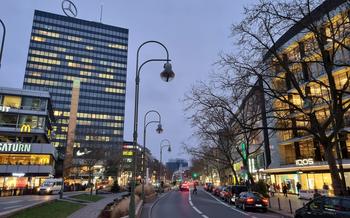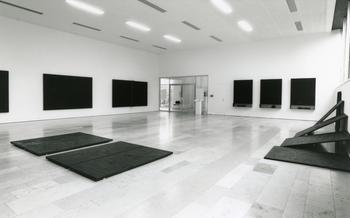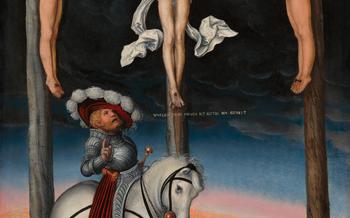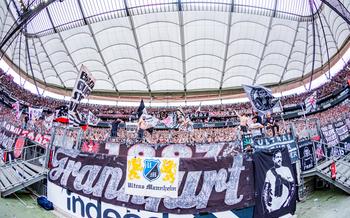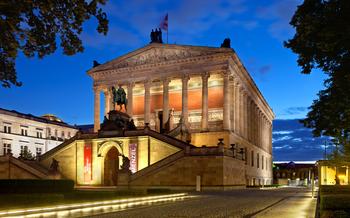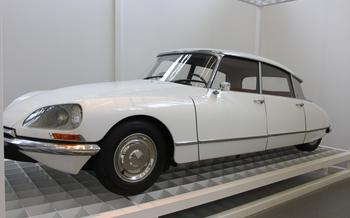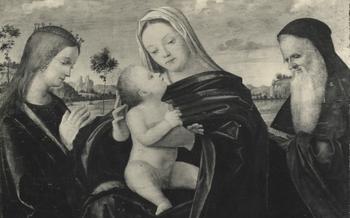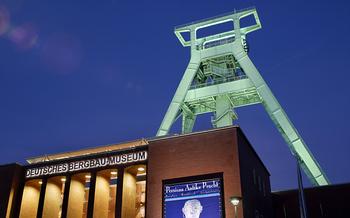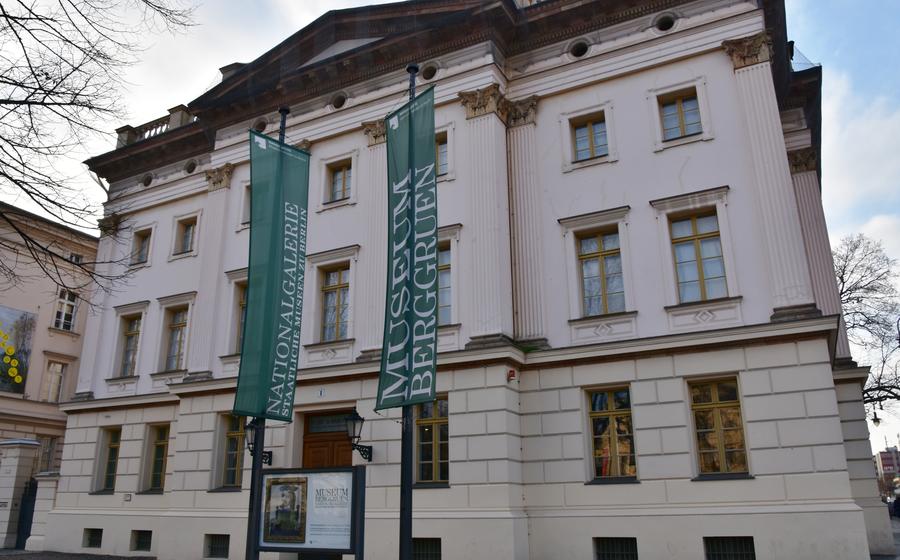
The Berggruen Museum
- The Berggruen Museum: An Oasis of Modern Art in Berlin
- Location and Getting There
- Hours of Operation and Admission Fees
- Navigating the Museum
- Pablo Picasso Masterpieces
- Henri Matisse's Vibrant Palette
- Paul Klee's Dreamlike Imagery
- Alberto Giacometti's Existential Sculptures
- Special Exhibitions and Events
- Nearby Attractions: Unveiling Berlin's Cultural Treasures
- Photography and Social Media
- Accessibility and Inclusivity
- Conservation and Research
- Insider Tip: Hidden Gems
The Berggruen Museum: An Oasis of Modern Art in Berlin
The Berggruen Museum, nestled in the heart of Berlin's vibrant Charlottenburg district, stands as an oasis of modern art, showcasing a remarkable collection assembled by the passionate art collector Heinz Berggruen. Founded in 1996, the museum is a testament to Berggruen's vision and his enduring legacy as a champion of 20th-century art.
Heinz Berggruen, a German-born art dealer and collector, played a pivotal role in shaping the art world during the post-war era. With an astute eye for talent and a deep appreciation for modernism, Berggruen amassed an extraordinary collection of artworks that spanned various artistic movements, including Cubism, Expressionism, and Surrealism.
Driven by his passion for art and his desire to share it with the public, Berggruen entered into a groundbreaking agreement with the Berlin State Museums in 198This agreement paved the way for the establishment of the Berggruen Museum, ensuring that his cherished collection would find a permanent home in Berlin, a city renowned for its rich cultural heritage.
The museum's unique architecture, designed by the renowned architect Oswald Mathias Ungers, complements the remarkable collection within. The building's modern, minimalist design creates a harmonious backdrop for the artworks, allowing them to take center stage and captivate visitors with their aesthetic brilliance.
Location and Getting There
Nestled in the heart of Berlin's Charlottenburg district, the Berggruen Museum is surrounded by a vibrant cultural tapestry. Charlottenburg itself is a treasure trove of historical landmarks and architectural wonders, making it an ideal starting point for exploring the city's rich heritage. The museum's proximity to other cultural attractions, such as the Museum Berggruen, the Bröhan Museum, and the Sammlung Scharf-Gerstenberg, invites visitors to embark on an art-filled journey through the ages.
Reaching the Berggruen Museum is a breeze, thanks to Berlin's efficient public transportation system. Several bus lines and the U-Bahn (subway) stop within walking distance of the museum, ensuring seamless connectivity from all corners of the city. Alternatively, taxis are readily available for those who prefer a more direct route. For those who enjoy exploring at their own pace, the museum is a pleasant walk away from popular shopping streets like Kurfürstendamm and Tauentzienstraße, allowing visitors to combine cultural immersion with retail therapy.
Hours of Operation and Admission Fees
The Berggruen Museum welcomes art enthusiasts with open doors during its regular hours of operation. From Tuesday to Sunday, visitors can immerse themselves in the world of modern art from 10 am to 6 pm. Mondays are dedicated to behind-the-scenes activities, offering a respite for curatorial work and preparation for upcoming exhibitions.
The museum understands the importance of accessibility and offers a range of admission fees to cater to diverse audiences. Regular admission tickets for adults stand at a reasonable [price], while students and children benefit from discounted rates. Group discounts are available for organized tours, providing an opportunity for educational institutions and art enthusiasts to experience the museum's treasures together.
To further encourage engagement and inclusivity, the Berggruen Museum offers free admission on select days or for specific groups. These initiatives aim to break down barriers and create equal access to art, enabling individuals from all walks of life to appreciate the museum's exceptional collection.
Navigating the Museum
The Berggruen Museum is designed to provide visitors with a seamless and enriching experience. The exhibition space is structured into thematic sections, allowing visitors to trace the evolution of modern art through the works of the featured artists. Chronological order is maintained within each section, providing a clear narrative of artistic development. Interactive displays and multimedia guides are available to enhance the visitor experience, offering insights into the lives and influences of the artists. Visitors with disabilities are well-catered for, with wheelchair accessibility, ramps, and adapted restrooms ensuring a comfortable and enjoyable visit for all.
Pablo Picasso Masterpieces
Among the treasures of the Berggruen Museum, the works of Pablo Picasso stand out as a testament to his artistic genius and profound influence on 20th-century art. The museum houses a significant collection of Picasso's paintings, sculptures, and drawings, offering visitors an immersive journey through his artistic evolution.
One of the highlights of the collection is the painting "The Old Guitarist" (1903-1904), created during Picasso's Blue Period. This somber and melancholic work portrays a blind guitarist hunched over his instrument, capturing the essence of human suffering and isolation. In contrast, "The Three Musicians" (1921) exudes a sense of harmony and camaraderie, depicting three masked figures engaged in a musical performance.
The museum also features several sculptures by Picasso, including "Head of a Woman" (1909), a striking and angular bronze bust that demonstrates his experimentation with Cubism. His famous "Man with Sheep" (1943), a whimsical and elongated bronze sculpture, showcases his ability to transform ordinary subjects into extraordinary works of art.
Heinz Berggruen's personal connection to Picasso played a crucial role in shaping the museum's collection. The two men shared a deep friendship and mutual admiration, resulting in Berggruen acquiring numerous significant works directly from the artist. These masterpieces not only represent the breadth and diversity of Picasso's artistic output but also serve as a testament to the enduring legacy of their friendship.
Henri Matisse's Vibrant Palette
Among the treasures of the Berggruen Museum, Henri Matisse's works stand out with their vibrant colors and expressive forms. A key figure in the Fauvism movement, Matisse revolutionized the art world with his bold use of pure colors and simplified shapes. The museum's collection features a range of his masterpieces, offering a comprehensive overview of his artistic journey.
One of the highlights is Matisse's painting "Blue Nude," created in 190This iconic work epitomizes his early Fauvism style, characterized by intense, non-naturalistic colors and simplified forms. The painting depicts a reclining nude figure rendered in vibrant shades of blue, green, and yellow, exuding a sense of harmony and serenity.
Another notable work is "Woman with a Hat," painted in 190In this portrait, Matisse portrays a woman with a large, colorful hat, using bold brushstrokes and contrasting hues to create a sense of movement and energy. The painting exemplifies his transition from Impressionism to Fauvism, as he breaks free from traditional conventions and embraces a more expressive style.
Matisse's cut-outs, created towards the end of his career due to declining health, are also represented in the collection. These works, composed of vibrantly colored paper shapes, demonstrate his continued experimentation with form and color. The museum displays several of these cut-outs, including the monumental "Blue Nude II," which exemplifies his ability to create dynamic compositions using simple elements.
Through these masterpieces, the Berggruen Museum offers a captivating journey into the world of Henri Matisse, showcasing his innovative use of color, form, and composition. His works continue to inspire and captivate viewers, leaving a lasting impression on those who encounter them.
Paul Klee's Dreamlike Imagery
Paul Klee's works, displayed in the Berggruen Museum, offer a journey into a realm of dreamlike imagery and abstraction. Renowned for his unique visual language, Klee's paintings, drawings, and watercolors explore the realms of the subconscious, blurring the boundaries between reality and imagination.
With a focus on abstraction and surrealism, Klee's artworks invite viewers to delve into a world of symbols, colors, and lines that defy conventional representation. His paintings, often characterized by a childlike simplicity, conceal a profound exploration of complex themes, ranging from music and nature to philosophy and spirituality.
Among the highlights of Klee's collection at the Berggruen Museum are his abstract landscapes, where floating forms and vibrant colors create a sense of ethereal mystery. His works, such as "The Twittering Machine" and "The Fish Magic," showcase his mastery of color theory and composition, where each element contributes to the overall harmony and balance of the artwork.
Klee's watercolors, with their delicate washes and subtle nuances, offer a glimpse into the artist's intimate and poetic world. His drawings, often executed with a playful and spontaneous line, reveal his fascination with the subconscious and the interplay of forms.
Through Klee's dreamlike imagery, viewers are invited to embark on a journey of introspection, where the boundaries of reality dissolve, and the imagination takes flight. His works continue to captivate and inspire, inviting viewers to explore the depths of their own subconscious and find new perspectives on the world around them.
Alberto Giacometti's Existential Sculptures
Alberto Giacometti, a Swiss sculptor, is another prominent artist featured in the Berggruen Museum. His sculptures, characterized by their elongated and skeletal figures, evoke a sense of isolation and vulnerability. Giacometti's works explore existential themes, delving into the human condition and the search for meaning in a seemingly meaningless world.
Among the highlights of Giacometti's collection at the Berggruen Museum are his iconic sculptures, such as "Walking Man I" and "Woman with Chariot." These works exemplify his unique style, capturing the essence of human movement and emotion through their attenuated forms. Giacometti's sculptures are often cast in bronze, plaster, or stone, materials that contribute to their sense of fragility and impermanence.
Giacometti's sculptures have a profound impact on viewers, inviting them to contemplate the complexities of human existence. His exploration of existential themes resonates with many, as his works speak to the universal struggles of isolation, vulnerability, and the search for meaning in life.
Special Exhibitions and Events
Beyond its permanent collection, the Berggruen Museum regularly presents temporary exhibitions that showcase works from its own holdings or external loans. These exhibitions offer a fresh perspective on the museum's collection and provide an opportunity to explore specific themes or artistic movements in greater depth.
Thematic events, workshops, and lectures complement the exhibitions, allowing visitors to engage with the art and artists in a more interactive and immersive way. Collaborations with other cultural institutions further enrich the museum's programming, bringing together diverse perspectives and expertise.
Special exhibitions and events are an excellent way to delve deeper into the world of modern art and gain new insights into the works of Berggruen's renowned collection. They offer opportunities for in-depth exploration, intellectual stimulation, and a deeper appreciation of the museum's artistic treasures.
Nearby Attractions: Unveiling Berlin's Cultural Treasures
Beyond the Berggruen Museum's captivating walls, a myriad of cultural attractions await exploration, all within arm's reach. Immerse yourself in history at the majestic Charlottenburg Palace, a stunning Baroque masterpiece surrounded by sprawling gardens. Stroll along the elegant streets, lined with boutiques, cafés, and galleries, offering a delightful blend of shopping and cultural experiences.
For art enthusiasts, the neighborhood is a haven, with numerous museums and galleries showcasing diverse artistic expressions. Explore the Old National Gallery, home to masterpieces from the 19th century, or delve into contemporary art at the C/O Berlin, renowned for its cutting-edge exhibitions.
Create your own unique itinerary, combining the Berggruen Museum's modern art treasures with the rich cultural tapestry of the Charlottenburg district. Discover hidden gems, savor delectable cuisine, and indulge in the vibrant atmosphere that makes Berlin a cultural metropolis par excellence.
Photography and Social Media
The Berggruen Museum encourages visitors to capture and share their experiences through photography. While flash photography and tripods are not permitted to ensure the preservation of the artworks, visitors are welcome to take photographs for personal use. The museum embraces the power of social media as a platform for engagement and community building. Visitors are encouraged to share their photographs, thoughts, and impressions using the hashtag #BerggruenMuseum. The museum actively maintains a presence on platforms like Instagram and Facebook, providing insights into the collection, behind-the-scenes glimpses, and upcoming events. By sharing their experiences and connecting with others, visitors become part of a global community of art enthusiasts, fostering a sense of belonging and shared appreciation for the masterpieces housed within the Berggruen Museum.
Accessibility and Inclusivity
The Berggruen Museum is committed to creating an inclusive and welcoming environment for all visitors. Wheelchair accessibility is ensured throughout the museum, with ramps and elevators providing easy access to all exhibition spaces. Visitors with disabilities can borrow wheelchairs from the museum's information desk. Multilingual audio guides are available in various languages, allowing visitors to explore the collection in their preferred language.
The museum also offers educational programs and resources tailored to schools and families. Guided tours can be arranged for groups, providing an in-depth exploration of the artworks and their significance. Educational workshops and activities are conducted regularly, encouraging children to engage with art in a fun and interactive way.
The Berggruen Museum believes that art should be accessible to everyone, regardless of their background or abilities. By providing a range of accessibility features and educational programs, the museum strives to create a welcoming environment where all visitors can enjoy and appreciate the wonders of modern art.
Conservation and Research
The Berggruen Museum is dedicated to preserving and researching its collection of modern art. The museum's conservation team works tirelessly to ensure that the artworks remain in optimal condition for future generations to enjoy. They employ state-of-the-art techniques and collaborate with experts from around the world to address the unique challenges of preserving modern and contemporary art.
In addition to conservation efforts, the Berggruen Museum is actively involved in research and scholarship. The museum's curators conduct in-depth studies of the artworks in the collection, contributing to the understanding and appreciation of modern art. They organize conferences, symposia, and publications that bring together scholars, artists, and the public to engage in critical dialogue and exchange ideas.
The museum's commitment to conservation and research extends beyond its own walls. It collaborates with other museums, universities, and institutions to share knowledge and resources, and to promote the study and preservation of modern art. Through these collaborations, the Berggruen Museum contributes to the global community of scholars and art enthusiasts, enriching our understanding of modern art and its significance in our cultural heritage.
Insider Tip: Hidden Gems
Beyond the renowned masterpieces, the Berggruen Museum holds hidden gems waiting to be discovered. One such treasure is a small, unassuming painting by Paul Klee titled "The Twittering Machine." This whimsical work depicts a fantastical contraption that seems to emit musical notes. Klee's intricate brushwork and vibrant colors bring the machine to life, inviting viewers to contemplate the relationship between art, technology, and the natural world.
Another hidden gem is a sculpture by Alberto Giacometti called "The Nose." This elongated and distorted bronze sculpture captures the essence of human vulnerability and isolation. Giacometti's mastery of form and texture conveys a profound sense of existential angst, making this piece a powerful and thought-provoking work of art.
To fully appreciate these hidden gems, take your time exploring the museum's collection. Look beyond the famous names and discover the lesser-known works that offer unique insights into the minds of these artistic giants. Embrace the opportunity to find your own personal favorites and create a memorable museum experience.


